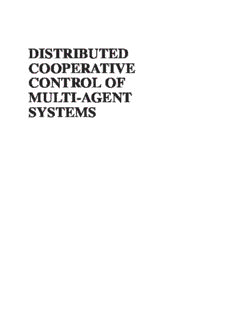Table Of ContentTrimSize:170mmx244mm (cid:2) Yu .tex V1-08/26/2016 11:38A.M. Pagei
DISTRIBUTED
COOPERATIVE
CONTROL OF
MULTI-AGENT
SYSTEMS
(cid:2) (cid:2)
(cid:2)
TrimSize:170mmx244mm (cid:2) Yu .tex V1-08/26/2016 11:38A.M. Pageiii
DISTRIBUTED
COOPERATIVE
CONTROL OF
MULTI-AGENT
SYSTEMS
Wenwu Yu
SoutheastUniversity,China
(cid:2) (cid:2)
Guanghui Wen
SoutheastUniversity,China
Guanrong Chen
CityUniversityofHongKong,China
Jinde Cao
SoutheastUniversity,China
(cid:2)
TrimSize:170mmx244mm (cid:2) Yu .tex V1-08/26/2016 11:38A.M. Pageiv
Thiseditionfirstpublished2016
©2016HigherEducationPress.Allrightsreserved.
PublishedbyJohnWiley&SonsSingaporePte.Ltd.,1FusionopolisWalk,#07-01SolarisSouth
Tower,Singapore138628,underexclusivelicensegrantedbyHigherEducationPressforallmediaand
languagesexcludingSimplifiedandTraditionalChineseandthroughouttheworldexcludingMainland
China,andwithnon-exclusivelicenseforelectronicversionsinMainlandChina.
Fordetailsofourglobaleditorialoffices,forcustomerservicesandforinformationabouthowtoapply
forpermissiontoreusethecopyrightmaterialinthisbookpleaseseeourwebsiteatwww.wiley.com.
AllRightsReserved.Nopartofthispublicationmaybereproduced,storedinaretrievalsystemor
transmitted,inanyformorbyanymeans,electronic,mechanical,photocopying,recording,scanning,
orotherwise,exceptasexpresslypermittedbylaw,withouteitherthepriorwrittenpermissionofthe
Publisher,orauthorizationthroughpaymentoftheappropriatephotocopyfeetotheCopyright
ClearanceCenter.RequestsforpermissionshouldbeaddressedtothePublisher,JohnWiley&Sons
SingaporePte.Ltd.,1FusionopolisWalk,#07-01SolarisSouthTower,Singapore138628,tel:
65-66438000,fax:65-66438008,email:[email protected].
Wileyalsopublishesitsbooksinavarietyofelectronicformats.Somecontentthatappearsinprint
maynotbeavailableinelectronicbooks.
Designationsusedbycompaniestodistinguishtheirproductsareoftenclaimedastrademarks.All
brandnamesandproductnamesusedinthisbookaretradenames,servicemarks,trademarksor
registeredtrademarksoftheirrespectiveowners.ThePublisherisnotassociatedwithanyproductor
vendormentionedinthisbook.Thispublicationisdesignedtoprovideaccurateandauthoritative
informationinregardtothesubjectmattercovered.ItissoldontheunderstandingthatthePublisheris
notengagedinrenderingprofessionalservices.Ifprofessionaladviceorotherexpertassistanceis
(cid:2) (cid:2)
required,theservicesofacompetentprofessionalshouldbesought.
LimitofLiability/DisclaimerofWarranty:Whilethepublisherandauthorhaveusedtheirbestefforts
inpreparingthisbook,theymakenorepresentationsorwarrantieswithrespecttotheaccuracyor
completenessofthecontentsofthisbookandspecificallydisclaimanyimpliedwarrantiesof
merchantabilityorfitnessforaparticularpurpose.Itissoldontheunderstandingthatthepublisheris
notengagedinrenderingprofessionalservicesandneitherthepublishernortheauthorshallbeliable
fordamagesarisingherefrom.Ifprofessionaladviceorotherexpertassistanceisrequired,theservices
ofacompetentprofessionalshouldbesought.
LibraryofCongressCataloging-in-PublicationData
Names:Yu,Wenwu,1982-
Title:Distributedcooperativecontrolofmulti-agentsystems/WenwuYu[and
fourothers].
Description:Singapore:JohnWiley&Sons,Inc.,[2016]|Includes
bibliographicalreferencesandindex.
Identifiers:LCCN2016018240(print)|LCCN2016023245(ebook)|ISBN
9781119246206(cloth)|ISBN9781119246237(pdf)|ISBN9781119246220
(epub)
Subjects:LCSH:Chaoticsynchronization.|Synchronization.|Systemanalysis.
Classification:LCCQ172.5.S96D572017(print)|LCCQ172.5.S96(ebook)|
DDC003/.7–dc23
LCrecordavailableathttps://lccn.loc.gov/2016018240
Typesetin11/13ptTimesLTStdbySPiGlobal,Chennai,India
10987654321
(cid:2)
(cid:2)
Contents
Preface ix
1 Introduction 1
1.1 Background 1
1.1.1 NetworkedMulti-agentSystems 1
1.1.2 CollectiveBehaviorsandCooperativeControlinMulti-agent
Systems 2
1.1.3 NetworkControlinMulti-agentSystems 4
1.1.4 DistributedConsensusFilteringinSensorNetworks 5
(cid:2) 1.2 Organization 6 (cid:2)
2 ConsensusinMulti-agentSystems 11
2.1 ConsensusinLinearMulti-agentSystems 11
2.1.1 Preliminaries 11
2.1.2 ModelFormulationandResults 13
2.2 ConsensusinNonlinearMulti-agentSystems 15
2.2.1 PreliminariesandModelFormulation 15
2.2.2 LocalConsensusofMulti-agentSystems 16
2.2.3 GlobalConsensusofMulti-agentSystemsinGeneral
Networks 19
2.2.4 GlobalConsensusofMulti-agentSystemsinVirtual
Networks 26
2.2.5 SimulationExamples 29
2.3 Notes 30
3 Second-OrderConsensusinMulti-agentSystems 31
3.1 Second-OrderConsensusinLinearMulti-agentSystems 32
3.1.1 ModelFormulation 32
3.1.2 Second-OrderConsensusinDirectedNetworks 33
3.1.3 Second-OrderConsensusinDelayedDirectedNetworks 37
3.1.4 SimulationExamples 41
(cid:2)
(cid:2)
vi Contents
3.2 Second-OrderConsensusinNonlinearMulti-agentSystems 42
3.2.1 Preliminaries 42
3.2.2 Second-OrderConsensusinStronglyConnectedNetworks 45
3.2.3 Second-OrderConsensusinRootedNetworks 50
3.2.4 SimulationExamples 53
3.3 Notes 54
4 Higher-OrderConsensusinMulti-agentSystems 56
4.1 Preliminaries 56
4.2 Higher-OrderConsensusinaGeneralForm 58
4.2.1 SynchronizationinComplexNetworks 58
4.2.2 Higher-OrderConsensusinaGeneralForm 59
4.2.3 ConsensusRegioninHigher-OrderConsensus 60
4.3 Leader-FollowerControlinMulti-agentSystems 64
4.3.1 Leader-FollowerControlinMulti-agentSystemswith
Full-StateFeedback 65
4.3.2 Leader-FollowerControlwithObservers 67
4.4 SimulationExamples 69
4.4.1 ConsensusRegions 69
4.4.2 Leader-FollowerControlwithFull-StateFeedback 70
(cid:2) 4.4.3 Leader-FollowerControlwithObservers 70 (cid:2)
4.5 Notes 71
5 StabilityAnalysisofSwarmingBehaviors 73
5.1 Preliminaries 73
5.2 AnalysisofSwarmCohesion 76
5.3 SwarmCohesioninaNoisyEnvironment 80
5.4 CohesioninSwarmswithSwitchedTopologies 82
5.5 CohesioninSwarmswithChangingTopologies 84
5.6 SimulationExamples 93
5.7 Notes 95
6 DistributedLeader-FollowerFlockingControl 96
6.1 Preliminaries 96
6.1.1 ModelFormulation 97
6.1.2 NonsmoothAnalysis 99
6.2 DistributedLeader-FollowerControlwithPinningObservers 103
6.3 SimulationExamples 110
6.4 Notes 114
7 ConsensusofMulti-agentSystemswithSampledData
Information 115
7.1 ProblemStatement 116
(cid:2)
(cid:2)
Contents vii
7.2 Second-OrderConsensusofMulti-agentSystemswithSampled
FullInformation 117
7.2.1 Second-OrderConsensusofMulti-agentSystemswith
SampledFullInformation 119
7.2.2 SelectionofSamplingPeriods 122
7.2.3 DesignofCouplingGains 123
7.2.4 ConsensusRegionfortheNetworkSpectrum 125
7.2.5 Second-OrderConsensusinDelayedUndirectedNetworks
withSampledPositionandVelocityData 125
7.2.6 SimulationExamples 128
7.3 Second-OrderConsensusofMulti-agentSystemswithSampled
PositionInformation 132
7.3.1 Second-OrderConsensusinMulti-agentDynamicalSystems
withSampledPositionData 132
7.3.2 SimulationExamples 139
7.4 ConsensusofMulti-agentSystemswithNonlinearDynamicsand
SampledInformation 142
7.4.1 TheCasewithaFixedandStronglyConnectedTopology 145
7.4.2 TheCasewithTopologyContainingaDirectedSpanningTree 149
7.4.3 TheCasewithTopologyHavingnoDirectedSpanningTree 155
7.5 Notes 158
(cid:2) (cid:2)
8 ConsensusofSecond-OrderMulti-agentSystemswith
IntermittentCommunication 159
8.1 ProblemStatement 159
8.2 TheCasewithaStronglyConnectedTopology 161
8.3 TheCasewithaTopologyHavingaDirectedSpanningTree 165
8.4 ConsensusofSecond-OrderMulti-agentSystemswithNonlinear
DynamicsandIntermittentCommunication 167
8.5 Notes 172
9 DistributedAdaptiveControlofMulti-agentSystems 174
9.1 DistributedAdaptiveControlinComplexNetworks 175
9.1.1 Preliminaries 175
9.1.2 DistributedAdaptiveControlinComplexNetworks 176
9.1.3 PinningEdgesControl 178
9.1.4 SimulationExamples 181
9.2 DistributedControlGainsDesignforSecond-OrderConsensusin
NonlinearMulti-agentSystems 183
9.2.1 Preliminaries 184
9.2.2 DistributedControlGainsDesign:LeaderlessCase 186
9.2.3 DistributedControlGainsDesign:Leader-FollowerCase 190
9.2.4 SimulationExamples 194
9.3 Notes 196
(cid:2)
(cid:2)
viii Contents
10 DistributedConsensusFilteringinSensorNetworks 198
10.1 Preliminaries 199
10.2 DistributedConsensusFiltersDesignforSensorNetworkswith
Fully-PinnedControllers 201
10.3 DistributedConsensusFiltersDesignforSensorNetworkswith
PinningControllers 205
10.4 DistributedConsensusFiltersDesignforSensorNetworkswith
PinningObservers 207
10.5 SimulationExamples 210
10.6 Notes 213
11 Delay-InducedConsensusandQuasi-ConsensusinMulti-agent
Systems 214
11.1 ProblemStatement 214
11.2 Delay-InducedConsensusandQuasi-ConsensusinMulti-agent
DynamicalSystems 217
11.3 MotivationforQuasi-ConsensusAnalysis 223
11.4 SimulationExamples 224
11.5 Notes 228
12 ConclusionsandFutureWork 229
(cid:2) 12.1 Conclusions 229 (cid:2)
12.2 FutureWork 230
Bibliography 232
Index 241
(cid:2)
(cid:2)
Preface
In the natural, social and technological worlds, there are many large-scale complex
networkswithmultipleagentsforwhichcentralizedcontrolisoftendifficultoreven
impossibletoapply.Therefore,distributedcooperativecontrolofmulti-agentsystems
hasbeenwidelyinvestigatedforitseasyimplementation,strongrobustness,andhigh
self-organizability.Inamulti-agentsystemunderanetworkcommunicationstructure,
to cooperative with other agents, everyone needs to share information with its adja-
centpeerssothatallagentscanagreeonacommongoalofinterest.Recently,some
progresshasbeenmadeinanalyzingcollectivebehaviorsinsuchdynamicalnetworks
forwhichcloselyrelatedfocaltopicsaresynchronization,consensus,swarmingand
(cid:2) flocking.However,thereareveryfewbooksfocusingondistributedcooperativecon- (cid:2)
trol of multi-agent systems addressing a broad spectrum of scientific interest. It is
now clear that the impact of cooperative control of multiple autonomous agents in
engineeringandtechnologyisprominentandwillbefar-reaching.Thus,anin-depth
study with detailed analysis of this subject will benefit both theoretical research and
engineeringapplicationsinthenear-futuredevelopmentofrelatedtechnologies.
The authors of this book have been working together on distributed cooperative
control of multi-agent systems for about seven years with some relatively compre-
hensiveresultsdevelopedonthetopic.Thisbooksummariestheirmaincontributions
in the field with general background knowledge and information, for a broad disci-
pline, including particularly dynamics of general multi-agent systems, for example
first-order,second-orderandhigher-orderconsensus,aswellasswarmingandflock-
ing behaviors. Some technical issues about multi-agent systems with sampled data
information transmission, missing control input, adaptive control and filters design
arealsoinvestigated.
This book presents the basic knowledge along with a thorough review of
the-state-of-the-artprogressinthefield.Thecontentsofthebookaresummarizedas
follows: (1) first-order, second-order, and higher-order consensus are discussed for
both linear and nonlinear multi-agent systems in Chapters 2-4; (2) stability analysis
of a general swarming model with hybrid nonlinear profiles, stochastic noise, and
switching topologies is investigated in Chapter 5; (3) distributed leader-follower
flocking control for multi-agent dynamical systems with time-varying velocities
(cid:2)
(cid:2)
x Preface
is studied in Chapter 6; (4) hybrid control of multi-agent systems including
sampled-data control and intermittent control is further discussed in Chapters 7
and 8; (5) fully adaptive control protocols for multi-agent systems are designed in
Chapter9;(6)someapplicationstodistributedconsensusfilteringinsensornetworks
arepresentedinChapter10;(7)aninterestingproblemfordelay-inducedconsensus
in multi-agent systems with second-order dynamics is addressed in Chapter 11; (8)
conclusionsaredrawnwithfutureresearchoutlookinChapter12.
ThisworkissupportedbytheNationalNaturalScienceFoundationofChinaunder
Grant Nos. 61322302, 61304168, and by the Natural Science Foundationof Jiangsu
ProvinceofChinaunderGrantNo.BK20130595.Thefirstauthor,WenwuYu,would
like to express his deepest gratitude to his wife Lingling Yao and little daughter,
Zhiyao Yu for their love and unconditional support; this academic book a good gift
forthem.
WenwuYu,GuanghuiWen,GuanrongChen,andJindeCao
Winter,2015
(cid:2) (cid:2)
(cid:2)
(cid:2)
1
Introduction
1.1 Background
1.1.1 Networked Multi-agent Systems
Mostlarge-scalesystemsinnatureandhumansocieties,suchasbiologicalneuralnet-
works,ecosystems,metabolicpathways,theInternet,theWWW,andelectricalpower
gridscanbedescribedbynetworkswithnodesrepresentingindividualsinthesystem
andedgesrepresentingtheconnectionsbetweenthem.Recently,thestudyofvarious
complex networks and systems has attracted increasing attention from researchers
in various fields of physics, mathematics, engineering, biology, and sociology alike
(cid:2) [8,35,62,90,117,118,119,123,142]. (cid:2)
Intheearly1960s,ErdösandRényi(ER)proposedarandom-graphmodel,which
laid a solid foundation for modern network theory [35]. In a random network, each
pairofnodesisconnectedwithacertainprobability.Inordertodescribeatransition
from a regular network to a random network, Watts and Strogatz (WS) proposed an
interestingsmall-worldnetworkmodel[123].Then,NewmanandWatts(NW)mod-
ified the original WS model to generate another version of the small-world model
[80].Meanwhile,BarabásiandAlbert(BA)proposedascale-freenetworkmodel,in
whichthedegreedistributionofthenodesfollowsapower-lawform[8].Sincethen,
small-worldandscale-freenetworkshavebeenextensivelyinvestigatedworldwide.
Cooperative and collective behaviors in networks of multiple autonomous agents
have also received considerable attention in recent years due to the growing interest
inunderstandingtheamazinganimalgroupbehaviors,suchasflockingandswarming,
andalsoduetotheiremergingbroadapplicationsinsensornetworks,UAV(unmanned
airvehicles)formations,androboticteams.Tocoordinatewithotheragentsinanet-
work, every agent needs to share information with its adjacent peers so that all can
agreeonacommongoalofinterest,suchasthevalueofsomemeasurementinasensor
network,theheadinginaUAVformation,orthetargetpositionofaroboticteam.
DistributedCooperativeControlofMulti-agentSystems,FirstEdition.
WenwuYu,GuanghuiWen,GuanrongChen,andJindeCao.
©2016HigherEducationPress.Allrightsreserved.Published2016byJohnWiley&SonsSingaporePte.Ltd.
(cid:2)

